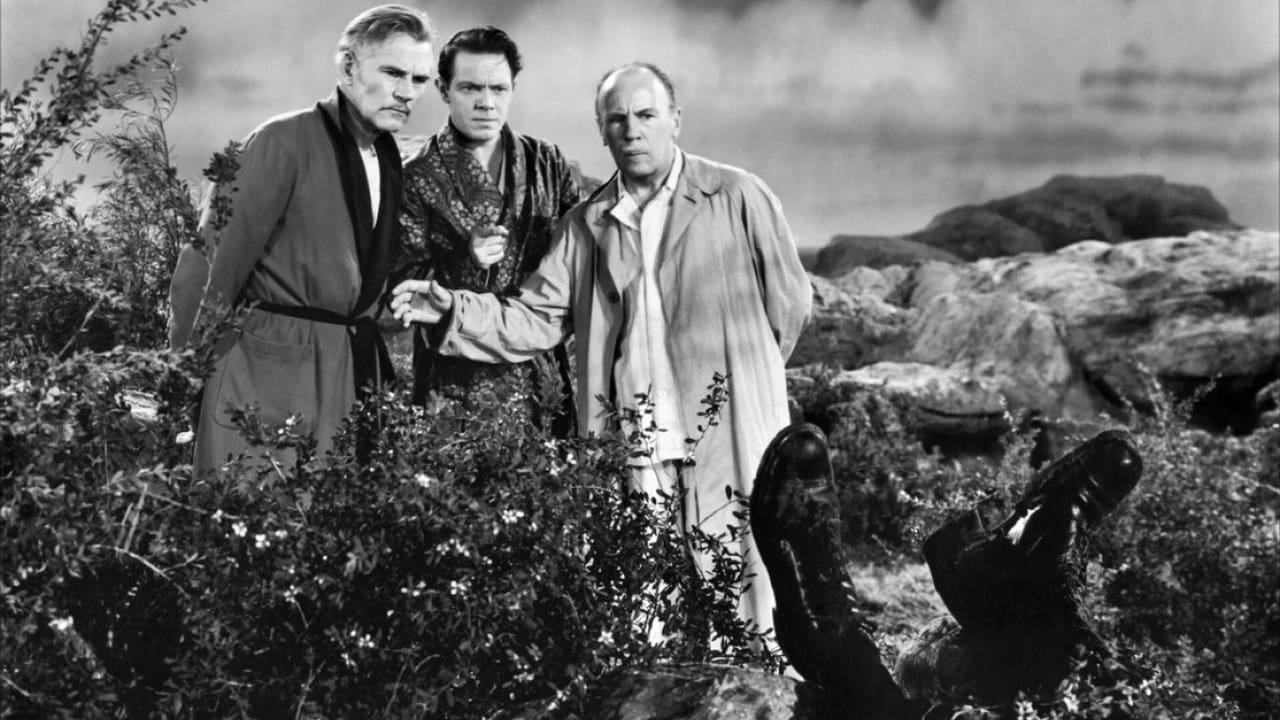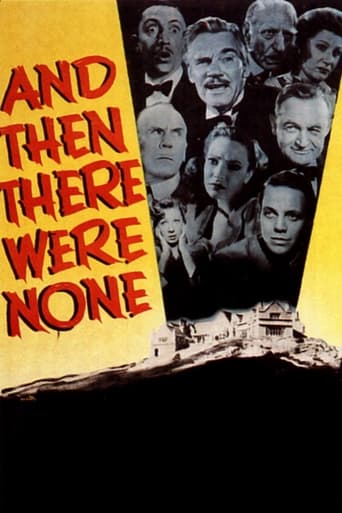

A Brilliant Conflict
... View MoreWhile it doesn't offer any answers, it both thrills and makes you think.
... View MoreGreat example of an old-fashioned, pure-at-heart escapist event movie that doesn't pretend to be anything that it's not and has boat loads of fun being its own ludicrous self.
... View MoreThe tone of this movie is interesting -- the stakes are both dramatic and high, but it's balanced with a lot of fun, tongue and cheek dialogue.
... View MoreAfter all the praise lavished on this film, I decided to watch it, in spite of knowing about the changed ending. Well, to put it short: if I hadn't read the book and watched the Soviet adaptation, I would have found this one absolutely charming. The actors are good (I especially liked the ones cast as Judge Quincannon and Emily Brent), the pace is fine, considering it was filmed seventy years ago. But nevertheless, first and foremost, it's an adaptation of Agatha Christie's masterpiece, and I viewed it as one.The good points of it:1) The shot fired by the judge and Dr. Armstrong when they stage the judge's murder. After all, it was the most reasonable thing to do. 2) The soundtrack. A splendid one (and catchy, too!)3) The judge's "game of the mind". A nice addition to his character. 4) The Rogers. Both well played, and their interaction was shown quite believably. The bad points:1) The whole comic atmosphere. Two of the reviewers compared the film to a parlor game, and I couldn't agree more. The mistrust, tension and fear that completely dominate the characters after Mrs. Rogers dies are simply absent here. Up to the very end, everyone seems to behave as if they're in a murder game. It's okay by itself, it's not like a detective comedy is bad, if you haven't read the book, that is.2) The general's reduced to a clown-like character, and his story (the most touching story of them all) is barely mentioned. 3) Blore is made an idiot. No: an IDIOT. Of course, he's not a genius in the book either, but here, I was shocked he had lived to his age at all, being so utterly brainless.4) The change in Vera's backstory. I wouldn't have minded it (although it seems pointless, like Beatrice Taylor being replaced by Peter Brent for no reason), but it makes the seaweed trick nonsensical. 5) Had to mention it. The ending. It seems that THIS judge's real plan was like "seven murders and one matchmaking". I thought he would have had his future victims' photographs! Why didn't he react to the wrong person (Morley)'s arrival? He searched for murderers so scrupulously, yet he failed to deduct that it was Vera's sister who was actually guilty. It seemed to me after watching the film that Lombard and Vera were in fact lying by the end. Why not? It would be very fitting for Lombard to make up a convincing story about him being another man. I mean, when a gun's pointed at you, you'll call yourself any name just to escape! As it's implied that Vera's sister is dead, Vera, too, could throw the blame on her to save her neck (she told Lombard about her sister before the killer was revealed, so she could have thought him Owen). So, it's a romantic comedy with some mystery thrown in-between, but so different in spirit from the original book it was hard to consider it an adaptation.
... View MoreA small boat chugs tirelessly through choppy seas, delivering its cargo of eight souls to a very remote island. In silence they suffer till they reach their destination. Upon arriving, they introduce themselves and find that their host, a Mr. Owen, is absent. However, a married butler and cook are present to attend to their needs.This is the setting for Agatha Christie's quintessential murder mystery. Soon the guests are advised of Mr. Owen's intentions, and the games begin. Try to figure out who the murderer is before the truth is revealed. The guests, including a judge played by Barry Fitzgerald and a doctor played by Walter Huston, devise strategies to uncover the perpetrator, but he/she is a devious devil.The real star of the film is the story, Christie's ingenious invention that still thrills, though it had more impact when it was first written, before others had purloined her plot (aka "Ten Little Indians").The version I watched on TCM was somewhat murky and the musical notes of the score seemed to bleed into one another, but it was sufficient to appreciate this classic whodunit.
... View MoreOn a cold and windy afternoon, eight strangers arrive on isolated "Indian Island" off the southern coast of England. They join two newly hired servants for a dinner hosted by the mysterious couple known only as "Mr. and Mrs. U.N. Owen". The ten people settle into Owen's mansion and prepare for dinner. Strangely, they seem to be the only ones on Indian Island. Their host and hostess are discovered to be absent, but Owen leaves a recording which accuses each guest of murder in various degrees. Understandably, most want to leave the island quickly – but there is no boat. Then, the "Ten Little Indian" islanders begin to drop dead, one-by-one. Like the nursery rhyme, a figurine on the dining room table features "Ten Little Indians". Every time a guest dies, one of the small Indians is broken...The ensemble must discover what is happening before they are all gone, thus ending the rhyme, "and then there were none"...This is a marvelous adaptation of Agatha Christie's stage play, itself based on her novel. Trying to solve the mystery is nearly impossible, especially if you've read the book. The differences, originally approved by Ms. Christie and brought to a witty screenplay by Dudley Nichols, make the plot perfect for the big screen. One character difference works especially well in the movies – in fact, this version delivers the story with a keen awareness of the medium (used as the singular of media; in this case, the movies). Giving character actors Barry Fitzgerald and Walter Huston top-billing, while casting lower case stars Louis Hayward and June Duprez in the romantic roles Director Rene Clair guides the cast and cameras around with elevating intrigue. This is the best of his short "Hollywood" career.********* And Then There Were None (10/31/45) Rene Clair ~ Barry Fitzgerald, Walter Huston, Louis Hayward, June Duprez
... View MoreWell, it was a famous exit line, so we'll never know if he finally did "get it" or not. This, the earliest screen version of the classic whodunit novel of the same name, takes some liberties with it, but remains the best version over the countless other versions of this story even after 70 years.Eight guests are invited and two house servants are hired to a secluded island by a man none of them knows. They learn all too late that they are being punished for murders they each got away with, when, one by one, each is being murdered. The murderer further taunts his remaining victims by marking each death with the disappearance of one of ten little Indians statues. He uses the Ten Little Indians poem as a framework for each murder. At first, it appears the murderer is hiding on the island somewhere, but soon it becomes evident he is one of the ten. Once everyone suspects each other, the tension builds well.Great characterizations are done by a wonderful cast, and the story unfolds in just the right manner to keep you guessing. The spooky house environment provides a perfect setting for the action.The original book's ending was stronger, but this movie's alternative works OK.See if you can guess whodunit, but be forewarned: if anybody named U.N. Owen, that you've never met, ever invites you to an island, turn down the invitation.
... View More